Review of the MASSIVE WD Red Pro 20TB Hard Drive for NAS
You really have to stop and marvel at the speed at which hard drives and storage, in general, grow every year. Despite the established rule of Moore’s law that these things double in size every two years, the very idea that Western Digital and their larger-scale NAS-focused WD Red Pro series of hard drives has now hit 20TB with the WD201KFGX is still a heck of an achievement (lest we forget that 22TB was also unveiled a month ago). Yet, in line with all this growth in storage, consumers’ and businesses’ appetite for storage continues to grow too and as big as 20TB of free space sounds, it is surprisingly easy for some to contemplate how they might fill it. Then you have to consider factors such as redundancy to prevent data loss in the event of failure, large-scale servers increasing the operational pressure on storage media, as well as the ability of any hard drive to withstand it all 24×7 and you can see why the WD Red Pro 20TB NAS hard drive has a great deal to live up to. The Red 20TB hard drive makes some bold promises in performance and robust design and with a price tag that very home users will be able to stomach, the direction for this drive towards business and enterprise use is understandable. So today, let’s review the WD Red Pro 20TB NAS hard drive, discuss how it is possible and ultimately help you decide if it deserves your data.
WD Red Pro 20TB Hard Drive Review – Quick Conclusion
The WD Red Pro 20TB is another great example of the brand’s continued investment in the NAS storage media industry that, although at its core a very functional item, still fulfils the promises and claims that the brand makes on it. The NAS hard drive market has become CONSIDERABLY busier and more populated in the decade or more since Western Digital unveiled their NAS storage media focus WD Red series, yet this Pro series 20TB offer still continues to maintain a high standard in its architecture and performance. The price tag is certainly quite brutal and although part of this stems from continued hardware and component shortages around the world, this is still a drive that is going to trade on its a rarity to a degree for a while. I say this because there are lower price alternatives for 20TB and server use right now from Western Digital themselves from the likes of the hyperscale and data centre-class UltraStar HC560 20TB, released a short while before the WD Red Pro 20TB, with similar architecture. Nevertheless, if your budget can cover the WD Red Pro 20TB, you have a larger scale NAS solution in mind and have no qualms about drive noise in it’s more sustained access periods, you cannot fault the WD Red Pro 20TB hard drive.
Where to Buy a Product





![]()
![]()

VISIT RETAILER ➤






![]()
![]()

VISIT RETAILER ➤
WD Red Pro 20TB Hard Drive Review – Specifications
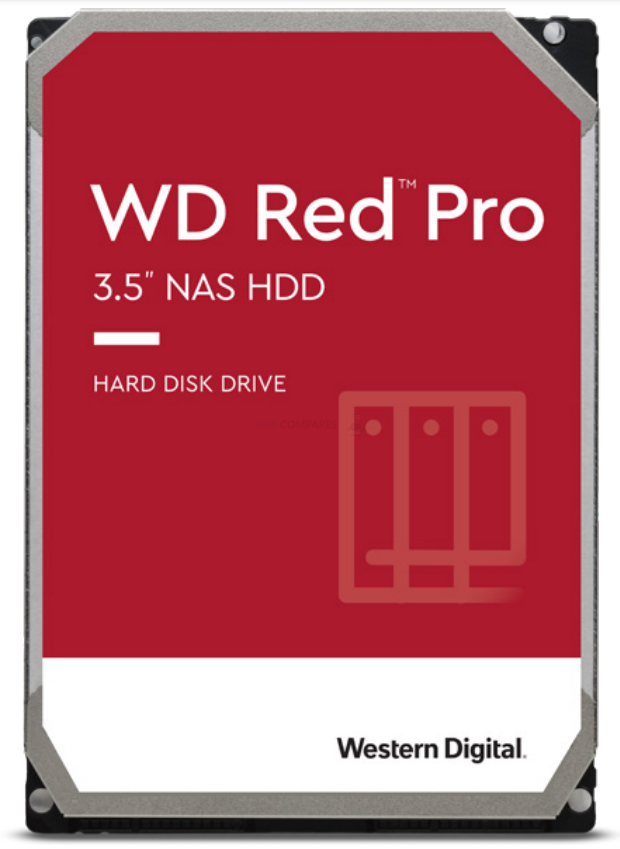
The hardware architecture of the WD Red Pro 20TB NAS hard drive is a combination of everything that we have seen in previous revisions of this long-running drive media series, combined with a new method of drive and data metadata management. This drive errs away from the energy-assisted magnetic recording of the Ultrastar 20TB released earlier in 2022, instead managing to provide this herculean 20 terabytes of storage via traditional conventional magnetic recording. It does this with data being split across nine 2.2TB platters internally, spinning 7200RPM and with 512MB of onboard cache for buffering. The Pro moniker in the model ID is based on portfolio separation in the WD Red series (featuring WD Red, WD Red Plus and WD Red Pro) with this new 20TB NAS HDD being heavily aimed at a larger scale business use. This architecture (along with the noise and vibration protection being handled by 3D Active Balance and geared with the NASWare 3.0 firmware) allows a 300TB per year workload rating, (data center class is 550TB), a 1 million hours MTBF rating and the brand including a 5-year warranty with the drive. Below is a greater breakdown of the WD Red Pro 20TB specifications:
| Model Number | WD201KFGX |
| Price | £612.99 at the time of writing |
| Formatted capacity | 20TB |
| Recording technology | CMR |
| Interface | SATA 6 Gb/s |
| Form factor | 3.5-inch |
| Native command queuing | Yes |
| Advanced Format (AF) | Yes |
| RoHS compliant5 | Yes |
| Controller | OptiNAND and iNAND, controller Combination SoC |
| SoC Architecture | 64-layer dynamic flash (BICS3) for metadata |
| Internal transfer rate | 268 MB/s |
| Cache (MB) | 512 |
| RPM | 7200 |
| Platters | 9x 2.2TB |
| Load/unload cycles | 600,000 |
| Non-recoverable errors per bits read | <10 in 1014 |
| MTBF (hours)8 | 1,000,000 |
| Workload rate (TB/year) | 300 |
| Limited warranty (years) | 5 |
| 12VDC ±5% (A, peak) | 1.80 |
| Read/Write Power Use | 6.9 (W) |
| Idle Power Use | 3.8 (W) |
| Standby and Sleep | 1.6 |
| Operating Temp | 0 to 65°C |
| Non-operating Temp | -40 to 70°C |
| Operating, (2 ms, read/write) | 30 (Gs) |
| Operating, (2 ms, read) | 50 (Gs) |
| Non-operating (2 ms) | 250 |
| Idle | 20 dBA |
| Seek (average) | 32 dBA |
| Height (in./mm, max) | 1.028/26.1 |
| Length (in./mm, max) | 5.787/147 |
| Width (in./mm, ± .01 in.) | 4/101.6 |
| Weight (lb/kg , ± 10%) | 1.52/0.69 |
What is OptiNAND and Why is it so Important?
Of course, users who have been following the developments of WD in their roadmaps and reveals of larger-scale drive media will be aware that the WD Red Pro 20TB also features a new technological design being rolled out in these bigger drives to merge existing storage technologies into something even better – OptiNAND. This is a new approach to an old idea that never really took off, where the benefits of small areas of faster NAND storage (more typically associated with SSD media) and affords a small area of NAND to a larger scale hard drive to be used for metadata and for storing data in the event of power failure. Flash is also interesting from a persistence standpoint. DRAM gets flushed on power loss, but NAND is non-volatile and can continue to keep metadata information without having to re-hydrate after a boot sequence, be removed from the system for some reason, or any other event where power drops. The WD Red Pro 20TB hard drive (much like other Western Digital 20TB drives currently) arrives with a portion of 64-layer/64GB BICS3 (3D TLC)

WD states that OptiNAND drives can secure more than 100MB of write cache data in the event of an unplanned power loss, a 50X improvement over standard drives that can flush about 2MB. Hybrid Drive media is not new, but whereas older generation hybrid drives were more parallel in architecture, this is far more intertwined. It also brings enhancements to the firmware algorithm and system-on-a-chip (SoC). Once again, to be clear, OptiNAND and its iNAND isn’t flash cache (such as the 512MB this drive also features). Rather, it’s a portion of flash memory used to store metadata–or data about existing data–so they can be managed more efficiently.

The slice of iNAND has its own dedicated controller, much like an SSD. While metadata management itself doesn’t help to increase platter density, it enables a range of benefits that do. As one can imagine, the higher the density of the HDD, the more metadata it generates. Moving metadata to a fast, dense and scalable storage area gives more freedom for manufacturers to create higher capacity drives.
| OptiNAND | DRAM |
 |
 |
But why choose NAND over DRAM? Western Digital explained back in August 2021 that modern high-density HDDs generate gigabytes of metadata and it’s too costly to include sufficient DRAM to hold it. In addition, moving metadata to their own dedicated area will free up more space on the platters themselves to store user data. There’s more to it than capacity increases, though; using OptiNAND also helps with reliability, specifically with the repeatable runout (RRO) and adjacent track interference (ATI).


WD Red Pro 20TB Hard Drive Review – Design
The design of the WD Red Pro 20TB Hard drive is quite uniform when compared to the 16TB and 18TB versions of the same drive. The green PCB seemed the tiniest pinch thinner and less pronounced in this drive – likely due to every single millimetre counting in efforts to ensure that the drive is still a standard sized 3.5″ class HDD. Indeed, the newest generation of hard drives (i.e ones that use larger numbers of platters and helium sealing) tend to be considerably more solid and industrial in appearance than ever.

The top of the WD Red Pro has the usual branded logos, technical details, firmware identification and date of production. The 20TB entries into the popular WD Red NAS media range have arrived remarkably quickly with this drive being produced less than two months before the writing of this review. For a while, WD was noticeably slower on rolling out larger capacities since the 12TB and 14TB drive era, but in the last couple of storage tiers they have caught up considerably with their release frequency.

The sides of the WD Red Pro 20TB are quite standard and exactly what you might expect, completely sealed from all sides and feature the usual screw holes. The interface of the drive is a SATA data+power connector that does manage to give you a little perspective about the height of this drive and the density of those contained platters in this 2.61cm high media casing (it pretty much maximizes the full conventionally available space a 3.5″ can suitably occupy in any NAS server bay right now. This SATA port allows the drive to provide a reported maximum performance of 268MB/s Sequential Read (the tiniest pinch lower than the 272MB/s of the 18TB WD Red Pro) which is still remarkably impressive, almost halfway saturating the bandwidth of SATA and closing in on the speeds of early SSD technology in the late 00’s and early teens.

The bulk of that area is occupied by those nine platters that are being read by a triple-stage actuator (an advancement on the standard arm that engages with the platters to retrieve data). This TSA means that errors and performance issues that can be associated with disks built on denser drive platters are hugely negated. Whether you are looking at NAS drives, SAN/Data-Center drives or even regular single deployment domestic hard drives, the bigger the drive in capacity, the more susceptible a drive can be to even the smallest vibration or shock passing through it from the host system. How does the WD Red Pro 20TB counter this?

The WD201KFGX 20TB (much like the rest of the WD Red and WD Red Pro series in the larger capacities) hugely benefits from the multi-axis shocker sensor and 3D active balance plus in the framework and firmware of the HDD, which means the drive’s heads and platters have their generated vibration and ambient shock/vibration from the larger NAS RAID configuration monitored and the drive proactively balances its performance. In short, this means that the drive can be more dynamic internally as surrounding system stress changes. Overall, what you have here is a very, VERY sturdy HDD. So, let’s see how that build quality translates into performance.

WD Red Pro 20TB Hard Drive Review – Testing
Testing the WD Red Pro 20TB is going to be performed across multiple methods, but still rather unconventional. This drive is designed for deployment in 8+ Bay servers and higher and although I have several NAS in the studio that could accommodate this frequency of drives, I do not have multiple WD Red Pro 20TB units. Therefore the testing I have conducted are all examples of single-drive performance. These will include several PC testing sessions using popular and recommended storage testing applications and two NAS tests involving Synology and QNAP.
- Windows 10 Pro Desktop System
- Intel i5 11400 Rocket Lake – 6-Core 2.6/4.4Ghz
- 16GB DDR4 2666MHz Memory
- Intel B560M mATX Motherboard
- OS Storage, Seagate Firecuda 120 SSD
- Test Hard Drive connected to a Sabrent USB 3.2 Gen 2 10Gb/s external dock
- Synology test was conducted on a DS920+ and DS2422+ NAS using the system’s own benchmarking tool
- QNAP test was conducted on a TS-464 NAS using the system’s own benchmarking tool
These last tests are important as not only is the WD Red Pro 20TB HDD designed for NAS use, but also at the time of writing neither brand lists this hard drive as compatible. There is more to this though that I will touch on later.

The first test involved using AJA. This test was using a 1GB test file (one test using a 1080p format and another being a massive 5K media file test). Unlike previous tests of SSDs here on NASCompares, a 16GB file over a SATA HDD will take quite a while and although it would be interesting to see how the WD Red Pro 20TB drive performs with this sustained largely sequential operation, I left heavy operations to later in the test routines.
 |
 |
Next, I performed a quick test on CrystalDiskMark using a 1GB test file, as well as mixed 70/30% R/W. The results were consistent and lived upto WD’s claims here.

The next test was using ATTO disk benchmark and this one was using a 1GB and 4GB test file in the same windows PC test environment. However, this test was focused more on the IOPS. The random 4K operations of a hard drive will typically be hugely dwarfed by those of HDDs, but enterprise HDDs and pro series drives still tend to rate noticeably higher than domestic HDD and standard class NAS HDDs on this score.
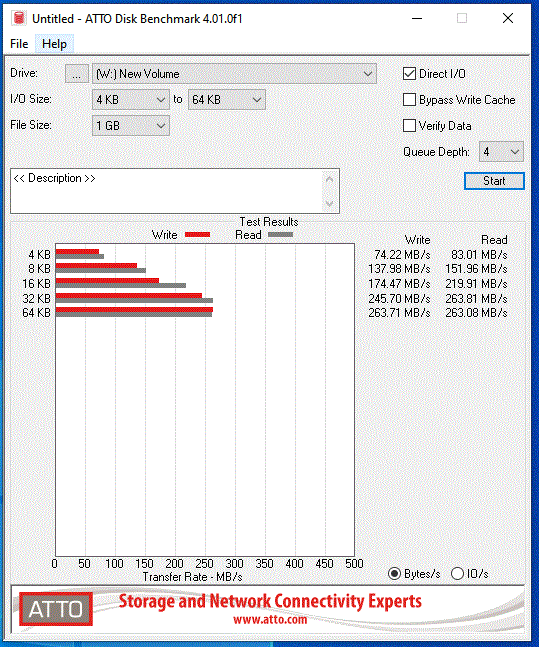 |
 |
 |
 |
Finally, I conducted a straightforward transfer onto the HDD using Windows File Explorer. This was done with a folder filled with a little over 20GB of mixed file types and volumes (2,250 files across 71 folders). This transfer took a fraction under 2 mins:
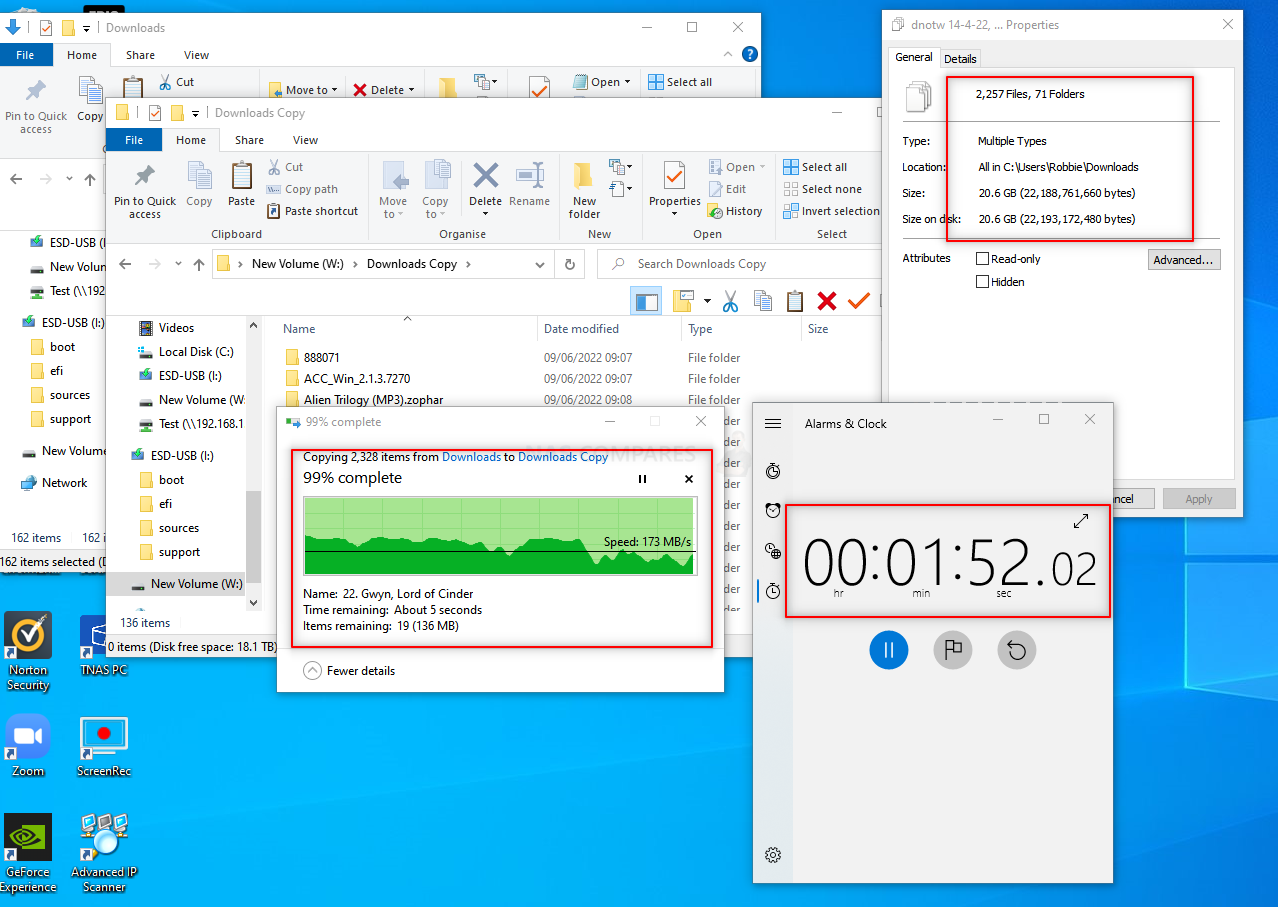
Synology & QNAP NAS Testing with the WD Red Pro 20TB Hard Drive
Now, before I move on to the NAS testing. It is worth highlighting a couple of important factors with regard to the WD Red Pro 20TB and the support available from each NAS brand I am focusing on for the testing. Now, Synology is the ONLY NAS brand in the market that also has its own first-party HDDs available to users too. These are Originally Toshiba Enterprise-grade produced hard disks that have had a Synology-specific firmware applied to them. Now, why is this relevant? Well, because some larger-scale Synology products in 2022 onwards do not list other 3rd Party HDDs as compatible. Even then, if you look up some of the older 2020 released NAS drives currently in the market (such as the DS920+ for example), they DO list HDDs from the likes of Western Digital (and their WD Red, Ultrastar and Gold series) BUT they do not list drives larger than 16TB at the time of writing. This is an odd stance by the brand, when larger-scale 18TB and 20TB hard drives are available in the market and designed for NAS.
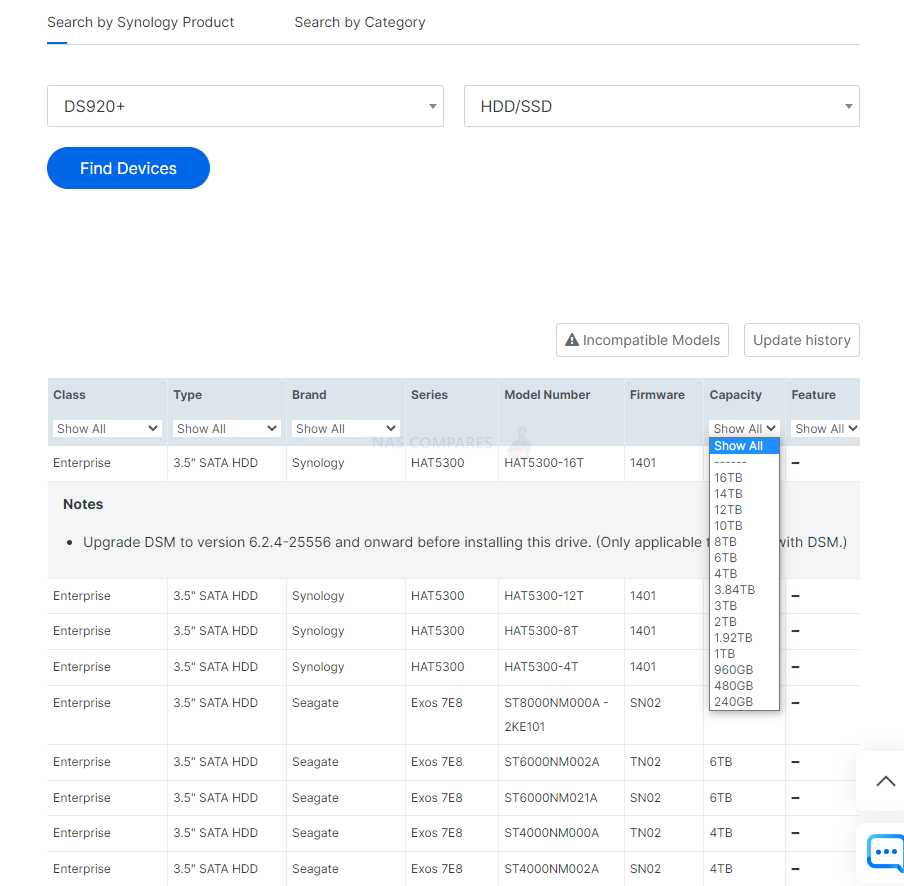
If you install an HDD or SSD inside a Synology system with the latest version of their software platform DSM, but the HDD in question is not on the compatibility list, you are greeted by a message that will detail that the drive is not recommended in the storage manager. You can still use the HDD for Storage Pools, Volumes, Hot-spares, etc, but it is an oddly jarring message for some.

Of course, this is the current compatibility of this HDD at the time of writing and may well change in the future as further HDD capacities arrive and additional compatibility testing takes place.
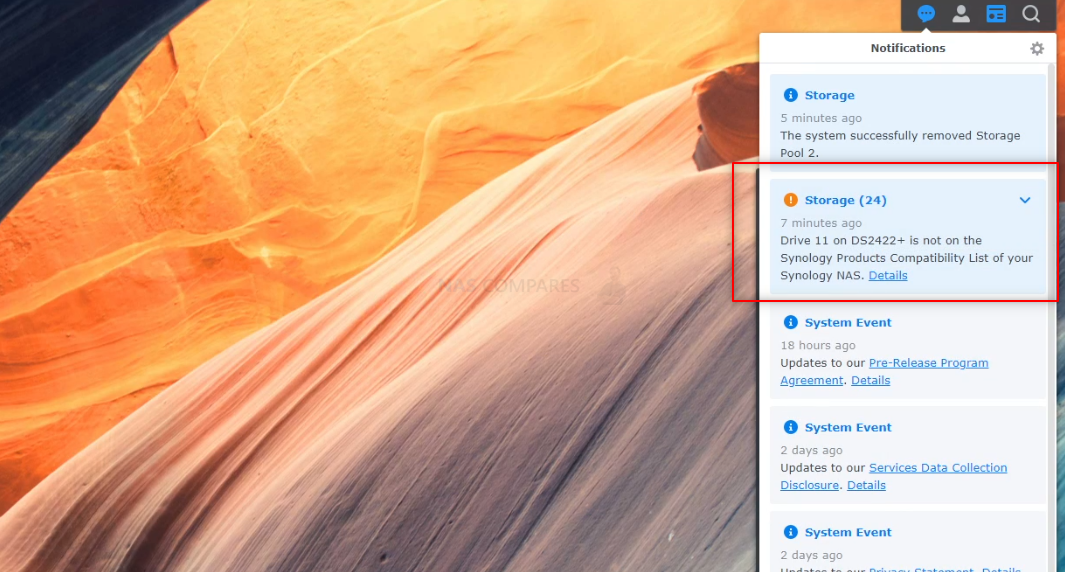
Nevertheless, you can still push through this warning and proceed to testing the performance of the WD Red Pro 20TB HDD from within the Synology Storage Manager. Here was the results.

The HDD compatibility of the WD Red Pro 20TB Hard drive on the QNAP NAS platform is less complicated (eg the 18TB HDDs from most brands are listed) but at the time of writing the 20TB models are still not on the available list of compatible HDDs (again, this will likely be addressed shortly after commercial launch). Here is how the drive is benchmarked and appeared in the QNAP NAS system.
Noise Testing the WD Red Pro 20TB NAS Hard Drive
Another factor that is all too often overlooked is the noise that is generated by pro and enterprise-class hard drives. Because these larger capacity and more durable drives are built to provide as high a performance as possible, as well as survive the rigours of more industrial deployment, they end up being noticeably noisier in use. Now, in larger rackmount installations, the noise of the NAS system fans and operation will easily drown out the noise of HDDs. However, these things are much, much different in smaller-scale deployment. Now that most HDD brands have shifted their portfolios to only include 14/16TB media and higher to only exist in their Pro/Enterprise class tiers, those buying more modest NAS systems in the 1-8-Bay scale will be much more likely to hear the noise of these more enduring HDDs. The WD Red Pro 20TB is not an especially quiet drive when in operation, even in idle. Here is how the drive sounds when the drive is powered on and on idle/standby (i.e no active file processes):
WD Red Pro 20TB Noise in a Synology DS920+ NAS – IDLE (click below – you may need to grant permission/access in the browser)
And here is how the WD Red Pro 20TB sounds when the HDD is being HEAVILY accessed. using a benchmarking tool and extensive random 4K IOPS in read/write testing. Note, the higher the frequency of files, the noisier it will be, as the actuator inside will be working considerably hardware to allocate the small size/high frequency of data to the platters):
WD Red Pro 20TB Noise in a Synology DS920+ NAS – HEAVY ACCESS (click below – you may need to grant permission/access in the browser)
Once again, if you are deploying this in a larger than 8-Bay NAS system (especially rackmount, but desktop too), then the clicks, hums and whirs of the WD Red Pro 20TB will not be especially noticeable above the general active fan noise of the host NAS system. But in smaller deployments and especially in setups where you will be in closer proximity with the NAS, this HDD will be especially noticeable and larger RAID NAS arrays will exacerbate the noise.
WD Red Pro 20TB Hard Drive Review – Conclusion
The WD Red Pro 20TB is another great example of the brand’s continued investment in the NAS storage media industry that, although at its core a very functional item, still fulfils the promises and claims that the brand makes on it. The NAS hard drive market has become CONSIDERABLY busier and more populated in the decade or more since Western Digital unveiled their NAS storage media focus WD Red series, yet this Pro series 20TB offer still continues to maintain a high standard in its architecture and performance. The price tag is certainly quite brutal and although part of this stems from continued hardware and component shortages around the world, this is still a drive that is going to trade on its a rarity to a degree for a while. I say this because there are lower price alternatives for 20TB and server use right now from Western Digital themselves from the likes of the hyperscale and data centre-class UltraStar HC560 20TB, released a short while before the WD Red Pro 20TB, with similar architecture. Nevertheless, if your budget can cover the WD Red Pro 20TB, you have a larger scale NAS solution in mind and have no qualms about drive noise in it’s more sustained access periods, you cannot fault the WD Red Pro 20TB hard drive.
| PROs of the WD Red Pro 20TB | CONs of the WD Red Pro 20TB |
| 20TB in a single 3.5″ drive is insane, even for 2022
OptiNAND concept and execution present performance and power-loss benefits NAS Server tailored HDDs are always a good thing for 24×7 deployment Good, solid internal hardware architecture at 7200RPM and 512MB traditional cache buffer Solid, if expected, 300TB workload rating 5yr warranty and good brand reputation for replacements & Support The 20TB Drives are (very) gradually appearing on NAS Compatibility Lists |
Even if you break it down to Price per TB, it IS a very expensive HDD
Not a quiet drive when in random active use The sequential data transfer rating is a fraction lower than the 18TB Red Pro
|
🔒 Join Inner Circle
Get an alert every time something gets added to this specific article!
This description contains links to Amazon. These links will take you to some of the products mentioned in today's content. As an Amazon Associate, I earn from qualifying purchases. Visit the NASCompares Deal Finder to find the best place to buy this device in your region, based on Service, Support and Reputation - Just Search for your NAS Drive in the Box Below
Need Advice on Data Storage from an Expert?
Finally, for free advice about your setup, just leave a message in the comments below here at NASCompares.com and we will get back to you. Need Help?
Where possible (and where appropriate) please provide as much information about your requirements, as then I can arrange the best answer and solution to your needs. Do not worry about your e-mail address being required, it will NOT be used in a mailing list and will NOT be used in any way other than to respond to your enquiry.
Need Help?
Where possible (and where appropriate) please provide as much information about your requirements, as then I can arrange the best answer and solution to your needs. Do not worry about your e-mail address being required, it will NOT be used in a mailing list and will NOT be used in any way other than to respond to your enquiry.

|
 |
The BEST NAS of 2026.... ALREADY??? (UnifyDrive UP6)
How Much RAM Do You Need in Your NAS?
A Buyer's Guide to Travel Routers - GET IT RIGHT, FIRST TIME
Jonsbo N6 DIY NAS Case Review
The Best Bits (and Worst Bits) of NAS of 2025!
Minisforum MS-02 Ultra Review
Access content via Patreon or KO-FI
Discover more from NAS Compares
Subscribe to get the latest posts sent to your email.






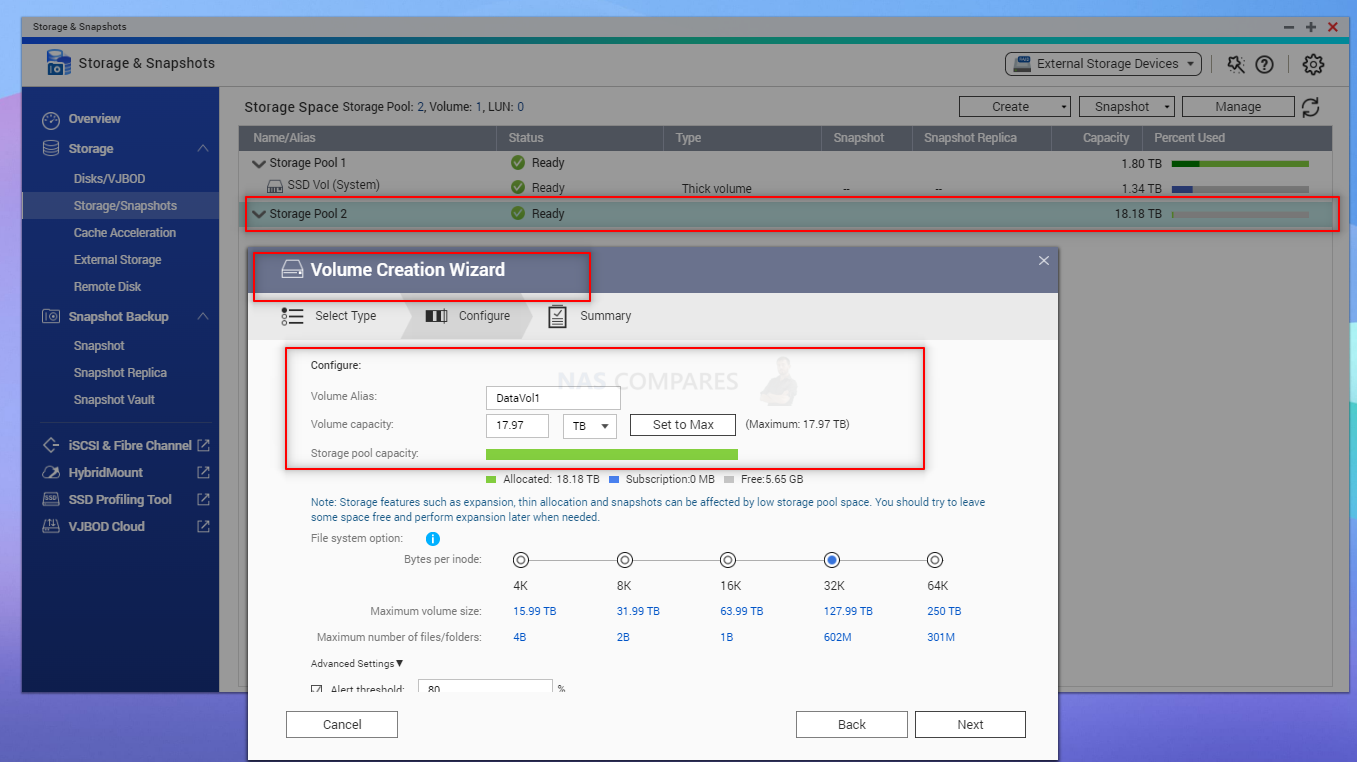






Any idea why the SN850X doesn’t work in a DS923+ ?
REPLY ON YOUTUBE
Great review, mate. Helped me to choose the drive ????
REPLY ON YOUTUBE
Maybe i missed it but is there a video of yours comparing the boise of the 20tb specifically to the 18tb. I currently have a bunch of 18tb shucked in synology nas in a loft situation so trying to keep noise down but maximizing hd size.I know this drive design as you state isnt just the next size up but a different design from the 18tb.
REPLY ON YOUTUBE
Curious I haven’t been able to find much info on the TS-462. I was thinking of purchasing and upgrading the memory. Also curious about what you think about TS-462 ability to stream 4k.
REPLY ON YOUTUBE
SSD’s are still too expensive per TB
REPLY ON YOUTUBE
Can you do a noise level test?
REPLY ON YOUTUBE
Terabytes… They’re called terabytes
REPLY ON YOUTUBE
I have the 18TB WD Red Pro. It doesn’t have the OptiNAND and it has 2TB platters but it’s still faster than this 20TB. OptiNAND might not be a good thing in terms of reliability either. You can’t swap a PCB on a HDD when that chip holds all the metadata. And if the chip goes bad it corrupts complete sectors at a time on the HDD. Also what happens to the data on NAND when you have it in poweroff state for years?
REPLY ON YOUTUBE
There is still somebody buying something from that liars in WD?
REPLY ON YOUTUBE
Great video, thank you. On the WD shop you can now buy a pair of these for £734.99 – bargain! Some people on hotukdals have managed to get a pair for £561. That’s cheaper per disk than Scan are selling the 10TB! Also, I have an Asustor AS5304T, is there any chance you can test these drives in that NAS? Thanks, Chris.
REPLY ON YOUTUBE
Thanks for the video.
On the QNAP, I guess the “Detected Incompatible Disk” message actually mean that the drive was previously used (partitioned) on Synology, obviously in a way the QTS doesn’t recognize. IMO, it has nothing to do with the compatibility list.
This is easy to test: just erase/zero the drive (partial erase would do) in a HDD dock, then try again.
L.E. I’ve actually seen this recently on the QNAP forum, someone attempted to migrate QuTS Hero (ZFS) formatted drives in a QTS (mdadm+EXT4) NAS (problem solved by switching the OS on the NAS to QuTS Hero). It’s a logical incompatibility, not at all what Synology is doing.
REPLY ON YOUTUBE
All is well to those who have money, damned poverty…
REPLY ON YOUTUBE
300tb / year workload makes this best in class _by itself_ at both the price point and capacity, not to mention that they didn’t skimp on cache & speed
REPLY ON YOUTUBE
300tb / year workload makes this best in class _by itself_ at both the price point and capacity, not to mention that they didn’t skimp on cache & speed
REPLY ON YOUTUBE
300tb / year workload makes this best in class _by itself_ at both the price point and capacity, not to mention that they didn’t skimp on cache & speed
REPLY ON YOUTUBE
300tb / year workload makes this best in class _by itself_ at both the price point and capacity, not to mention that they didn’t skimp on cache & speed
REPLY ON YOUTUBE
300tb / year workload makes this best in class _by itself_ at both the price point and capacity, not to mention that they didn’t skimp on cache & speed
REPLY ON YOUTUBE
69.5k subs *_niice_* **^.~**
REPLY ON YOUTUBE
69.5k subs *_niice_* **^.~**
REPLY ON YOUTUBE
69.5k subs *_niice_* **^.~**
REPLY ON YOUTUBE
69.5k subs *_niice_* **^.~**
REPLY ON YOUTUBE
69.5k subs *_niice_* **^.~**
REPLY ON YOUTUBE
As a guide, I ordered 2 4TB WD Reds for my Terramaster. They refused to work. So I bought Seagate instead. Marvellous.
REPLY ON YOUTUBE
I prefer my 20tb Exos. They work like a charm.
REPLY ON YOUTUBE
Great review, including some very helpful additional info. Thank you.
REPLY ON YOUTUBE
how long does a format will take on this 20TB drive
REPLY ON YOUTUBE
Hi is it possible to backup a usb hard drive connected to a Mac to a synology nas drive automatically??
REPLY ON YOUTUBE
Thanks for the great content!
When do you think we may see the brand new DS1823+ ? I’ve been holding off in anticipation of this unit… Also, do you think it will have the same restrictions pertaining to compatible drives as the DS2422+ ?
REPLY ON YOUTUBE
Got 3 x 16tb WD PRO, nice and cheap the other month £275 each, basically paid for the 6 bay QNAP enclosure.
REPLY ON YOUTUBE
Funny Robbie, ya missed on the edit at 21:00, and repeated yourself 3 times … just funny.
REPLY ON YOUTUBE
TBH the ridiculous price of “NAS” drives aren’t worth it these days. Just get enterprise instead, which is the better drive anyway. 20 TB Ultrastars is available for around €425. The one to get though is 18 TB variant at around €325.
REPLY ON YOUTUBE
From the WD product page we can see the Pro 20TB NAS drive uses CMR recording technology, and is suitable for ZFS or BTRFS error recovery schemes. The price is about $800 USD. What’s notable is these use CMR but the drives are hybrid SMR, but set at the factory in CMR-only mode. So this is great news!
REPLY ON YOUTUBE
Strange number of writes for these drives. A raid rebuild with only 300 TB for this drive that’s easy to reach in a server.
REPLY ON YOUTUBE
Thank you and my mind is a little wobbly now from the information dump. Well done. Cheers to you and the bloody seagulls, noisy rats with wings, nasty. Cheers!
REPLY ON YOUTUBE
Hai anna iam Nagendar Anna na age 42 Sweetlovee.Monster qualification m.l.t medical lab technicianf ,Srpt lo jobs unte cheppagalaru anna.with govt Jobs
REPLY ON YOUTUBE
And where is the Seagate matching 20TB drive?
REPLY ON YOUTUBE
Can we get it in SAS as well?
REPLY ON YOUTUBE
£600
Phew!
REPLY ON YOUTUBE
Cheers for watching! Just a quick note, I have a much, MUCH deeper video on NAS HDD Compatibility in the works that should be out later this week, featuring Synology, QNAP, Terramaster & Asustor and to what extent this new WD Red Pro 20TB NAS Hard Drive is compatible with them.
REPLY ON YOUTUBE
Commenting on this because it’s your most recent video rather than relevant to my question: hope you don’t mind! Your channel seems to be the primo nas info channel out there though.
I am a photographer and have a few TB of RAW images and archive tiffs. Up until now I’ve been working of an assortment of external HDs (unpowered HDD/SDD) plus Google drive.
I am looking for a device that allows me to have a working directory with all my photos that I can access from both a desktop and a laptop as well as do backups to a cloud backup offsite.
Is a NAS what I am looking for or do I just want a large external HDD?
If you answer this question in another video please let me know and I’ll watch that. Thanks!!!
REPLY ON YOUTUBE
I love hearing “rooters” when we say “r-out-ers” good video content
REPLY ON YOUTUBE
Related to your final point, quality video as always, Robbie. Thanks for all your hard work.
REPLY ON YOUTUBE